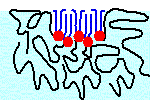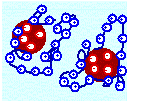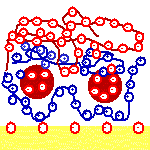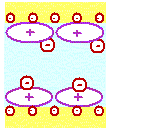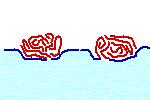What is 'Soft Matter'?
A rather large group of mostly organic materials is called soft condensed matter, for instance polymers, supramolecular structures of small organic molecules, liquid crystals, colloids, emulsions, biopolymers and biomembranes. Also included are structured and "interface dominated" materials such as microemulsions, block copolymers, foams, etc. All these materials are easily influenced by small external forces, they are "soft".
Well Known: Hard Condensed Matter
Large interatomar/intermolecular interaction energies (200-800 kBT/Molecule)
due to electrostatic, metallic or covalent bonds
stable if subject to high pressures, high temperatures, high electric fields, ...
Soft Condensed Matter
Weak Intermolecular Energies (< 25 kBT/Molecule)
- van der Waals and electrostatic force
- hydration and hydrophobic Force
- molecular size and shape
- entropic effects
- cooperative effects
When Does which Force Win? ... Very Complex Systems!
Intriguingly, a small change of one external parameter can induce a phase transition. For instance, a very prominent application is the liquid crystal display (LCD) used in watches or computer monitors. Still, many of the astonishing mechanical, electrical or optical properties found in nature are not yet realized in technical systems. Because they are not yet understood.
Biomimetic Systems
Even though Nature uses only very few chemical elements to build living matter (mainly H, C, N, O and P, with a little bit of Na, K, Cs, Cl, F, J, Sr, Ca, Mg, Mn, Fe, Zn) biomaterials are very complex. The cell of a bacterium consists of about 6000 different molecules. However, most biomolecules are just variations of a few basic molecular groups, mainly amino acids, nuclear bases, fatty acids, polyenes, phosphates and sugas. Biomaterials are self-organizing materials. The shape of the molecular groups, and the arrangement of hydrophobic, hydrophilic and charged groupes determine the supramolecular structures.
Structure of Self-Organized Interfaces
Monolayers at the Air Water Surface serve as model systems to probe the lateral interactions. In a Langmuir Trough many external parameters can be adjusted: temperature, area per molecule, content of salt, polymers or proteins in the water, organic molecules in the air side, etc. Additionally, the fluid interface is a large self-annealing surface, which is easily accessed by many techniques. We did and do research to address the following questions:
Specific protein binding to lipid monolayers with incorporated ligand molecules to mimic processes at cell membranes 1991
Nanocolloids have about the same radius as a swollen polymer coil. Like polyelectrolytes they are multiions. One may imagine two extrme cases, the polymer is either wrapped around the nanocolloid, or the nanocolloids are aligned on the polymer like beads on a string (bridging flocculation).
Polyion multilayers are technically interesting because the film composition parallel to the surface normal can be controlled on the nm-level. They are prepared by alternating adsorption of polycations and polyanions. 2001
Crystal nucleation and growth in two dimensions are (theoretically) simpler than in three dimensions, because there are less free parameters. The most intriguing and least understood problem concerns nucleation: the system is subject to large-scale fluctuations between saturated and supersaturated domains before a stable nucleus is formed. 1998
Phase transitions, surface induced ordering or demixing and multilayer formation of macromolecules is a fun problem. Especially if the forces from the two interfaces and the inter- and intraparticle forces are of the same order of magnitude, a rich phase behavior can be observed. 1999



